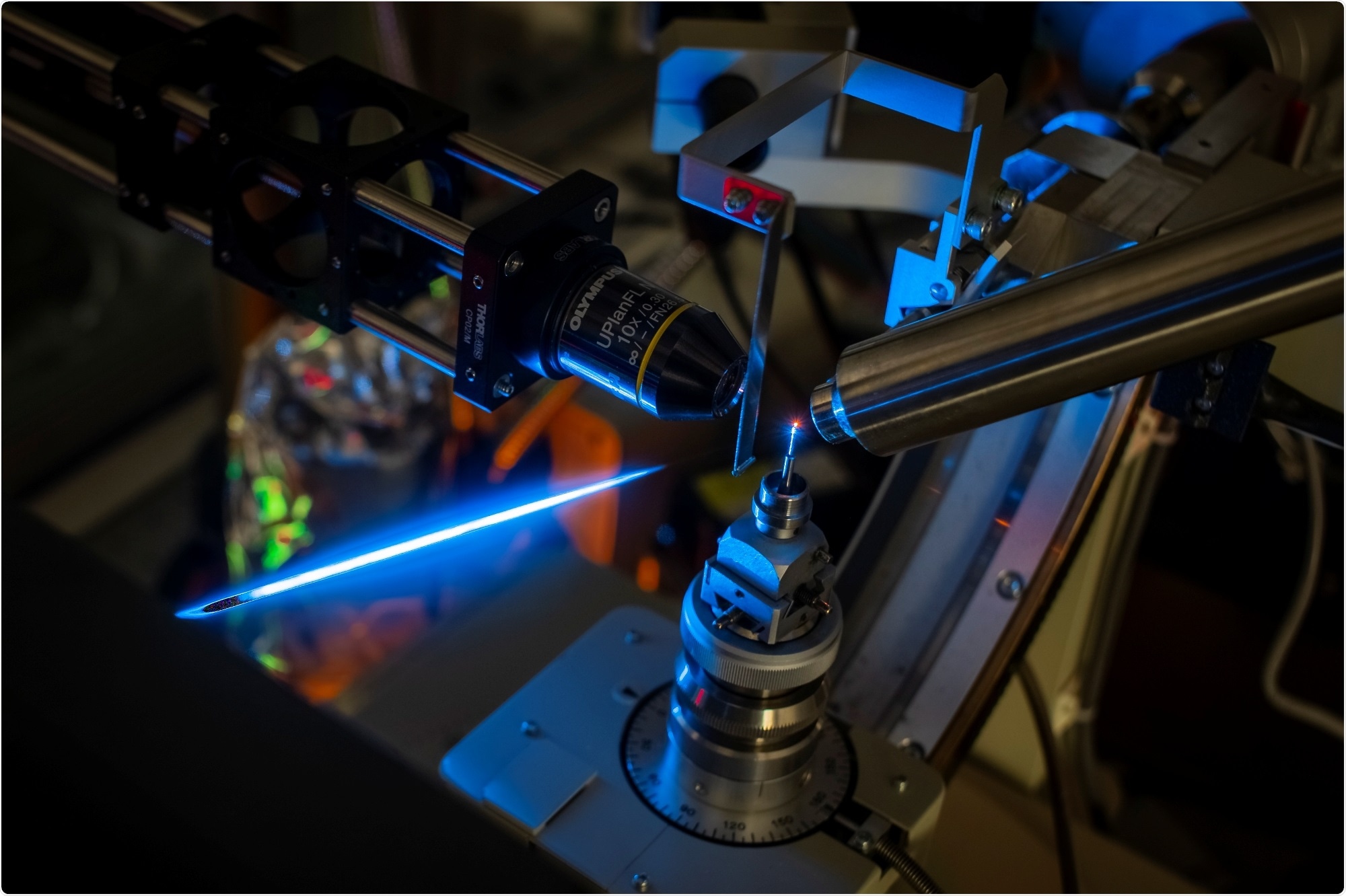Scientists headed by Josef Lazar from the Institute of Organic Chemistry and Biochemistry of the Czech Academy of Sciences (IOCB Prague) have revealed that fluorescent protein molecules serve as antennas with optical characteristics (that is, the potential to absorb and produce light) according to their spatial orientation.

A crystal of a red fluorescent protein placed in a combined instrument consisting of a fluorescence microscope and an X-ray diffractometer. The crystal glows red when illuminated by a blue laser beam. Image Credit: Petr Pach /Institute of Organic Chemistry and Biochemistry of the Czech Academy of Sciences (IOCB Prague).
Initially identified in jellyfish, fluorescent proteins are now extensively utilized in studies of molecular processes in both living organisms and cells. The recently described properties of these molecules could be used in fundamental biological research and also in new drug discovery.
A research team from IOCB Prague, the Institute of Microbiology, and the Institute of Molecular Genetics of the Czech Academy of Sciences has reported its findings in the Proceedings of the National Academy of Sciences of the United States of America.
Fluorescent proteins only absorb light from certain directions
To achieve these outcomes, the team used genetically modified bacteria to produce adequate amounts of fluorescent proteins, determined the conditions under which the proteins create crystals, and established the atomic structure of the crystals.
They also used a special microscope designed within the team and subsequently quantified how these crystals are able to absorb and discharge light, and using that information, they calculated the directional characteristics of the individual molecules. This enabled them to validate that the molecules of fluorescent proteins act as miniature antennas and not as small luminescent dots, as they are often mistakenly believed.
Just like antennas meant for WiFi, radio, and television transmission, such molecules only absorb light from specific directions. Similarly, these molecules only produce light in specific directions. The team also succeeded in accurately determining these directions.
The likelihood of fluorescent protein molecules acting as antennas that can absorb extraneous light had been believed for a long time, but over the years, it proved challenging to confirm, and this fact had restricted its applications.
Josef Lazar from IOCB Prague and his team, who deals in the development and application of sophisticated optical microscopy techniques, have now resolved these barriers.
Based on the findings of other laboratories and our own, we suspected that fluorescent protein molecules likely behaved as antennas. Nonetheless, we were surprised to see just how true that analogy is and how accurately we were able to establish the directions from which these molecules absorb light and emit it.”
Josef Lazar, Institute of Organic Chemistry and Biochemistry of the Czech Academy of Sciences
New ways of using fluorescent protein molecules
The fact that molecules of fluorescent proteins function as miniature antennas are fascinating not only as a curiosity of physics, but also have a major practical applications. Binding a fluorescent protein to a certain target protein involves fixing a miniature antenna to it that can subsequently be utilized to comprehensively establish the changes in the shape of the molecules of the target protein, directly in a living cell. Such variations in the shape of the molecules can be induced by a drug, for example.
Therefore, the current finding could be used for studying major physiological processes at the molecular level as well as in novel drug discovery.
The significance of our finding lies in the fact that even though fluorescent protein molecules are widely used in biological research, their ability to behave like antennas isn’t fully appreciated yet, nor is it really being put to use. Knowledge of the directional properties of fluorescent proteins can lead to new ways of using these useful molecules.”
Josef Lazar, Institute of Organic Chemistry and Biochemistry of the Czech Academy of Sciences
In association with other groups from IOCB Prague, Josef Lazar’s team is already taking efforts to implement the present results in, for instance, the analysis of the physiological effects of insulin and also in the development of insulin alternatives for peroral use.
Another example of a promising application of the current discovery is the tracing of electrical signals in nerve cells, which may prove useful for studying neurological diseases and the brain.